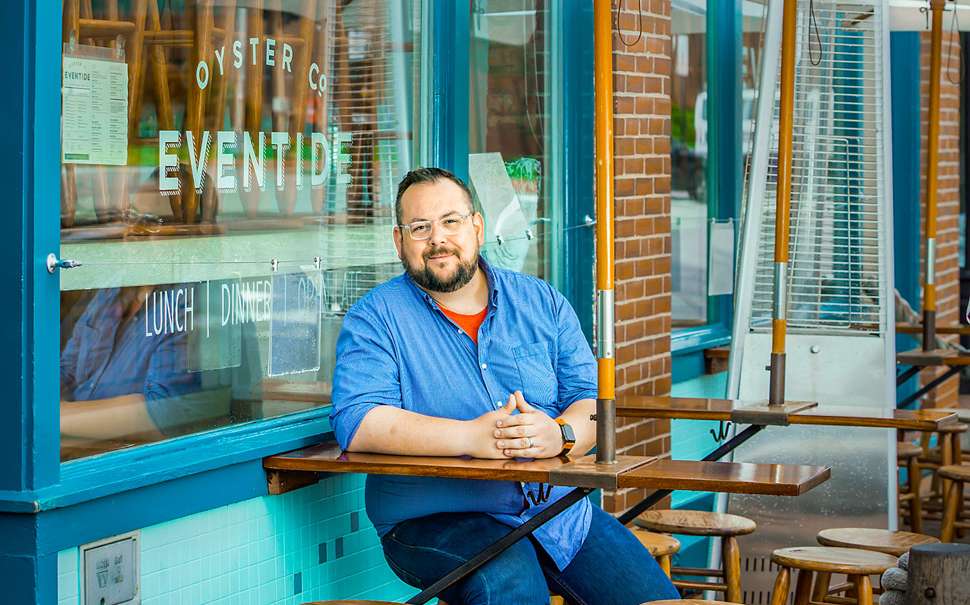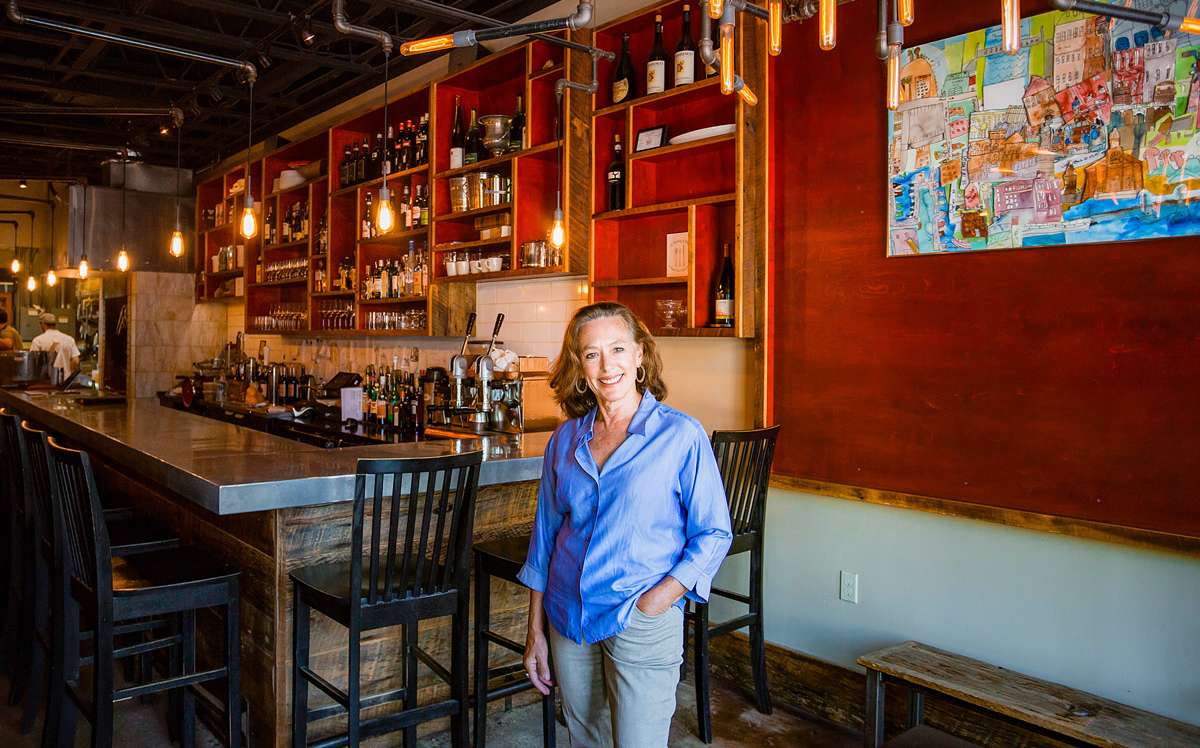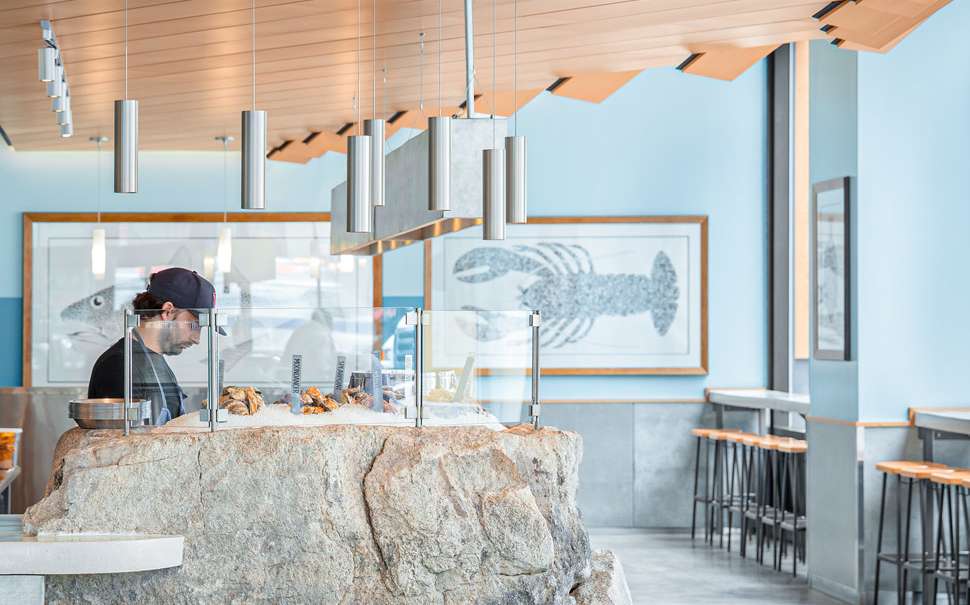
Processing Your Payment
Please do not leave this page until complete. This can take a few moments.
- News
-
Editions
View Digital Editions
Biweekly Issues
- December 15, 2025
- December 1, 2025
- Nov. 17, 2025
- November 03, 2025
- October 20, 2025
- October 6, 2025
- + More
Special Editions
- Lists
- Viewpoints
-
Our Events
Event Info
Award Honorees
- Calendar
- Biz Marketplace
Feast for the eyes: Portland’s foodie status keeps architects and brand experts busy
 Photo / Tim Greenway
Phil Kaplan, principal of Kaplan Thompson Architects, left, and the firm’s chief restaurant architect, Jamie Broadbent, in the Sagamore Hill Lounge in Portland.
Photo / Tim Greenway
Phil Kaplan, principal of Kaplan Thompson Architects, left, and the firm’s chief restaurant architect, Jamie Broadbent, in the Sagamore Hill Lounge in Portland.
Stuffed mounted bear and moose heads adorn the walls of Portland’s Sagamore Hill Lounge as Marvin Gaye’s “Mercy, Mercy Me” plays in the background. This combination vintage gentlemen’s club and chic drinking den pays homage to Theodore Roosevelt’s Sagamore Hill estate on Long Island, N.Y.
His spirit lives on in this West End temple of all things Teddy, from the black-walnut interior designed by Kaplan Thompson Architects to the menus, coasters and signs crafted by brand-design studio Might & Main.
Both are based in Portland — Bon Appétit magazine’s 2018 Restaurant City of the Year and 2019 Best-Ever Vacation Spot — and where restaurant owners are increasingly focusing on looks as well as taste.
“Because it’s such a high bar for food in Portland, restaurants want every edge,” says Jamie Broadbent, Kaplan Thompon’s chief restaurant architect. “The space has to be dynamite as well.”
While some restaurateurs hire architects only as consultants or for required permitting, others are splashing out on creative décor or design. Permitting alone can cost around $10,000. Design services not including construction typically run between $15,000 and $35,000.
As one of Portland’s only architectural firms with a restaurant specialty, Kaplan Thompson has a growing client roster that extends to Biddeford and Boston. Might & Main, whose local clients include Eventide Oyster Co., Duckfat, Crown Jewel and Evo Kitchen + Bar, is equally busy.

David Matero Architecture, based in Bath, is a small full-service firm that also does a lot of restaurant work. Its portfolio includes O’Reilly’s Cure Restaurant and Bar in Scarborough and two Kennebunk projects for Shipyard Brewing Co.’s Fred Forsley, including the brand-new Live Café.
Given the competitiveness and volatility of the restaurant business, the architecture firm’s founder and principal David Matero notes that not all owners have a lot to spend on decor or lighting, forcing designers to be more resourceful.
“Typically in our architecture,” he says, “we do as much as we can with as little as they can afford.”
Portland’s time to shine
In Portland, Kaplan Thompson has been designing restaurants since long before the city became trendy.
It started with Miyake, Masa Miyake’s Old Port sushi spot that won a 2012 award from the American Association of Architects, and that’s widely regarded as a breakout moment for Portland’s foodie scene.
“Other than Street and Co., which has a unique design, and Fore Street, I felt like that was one of the first times somebody paid a lot of attention to interior design,” notes Jim Brady, the developer behind Portland’s Press Hotel and Union Restaurant and a planned waterfront hotel set to break ground this October. “Since then, others are starting to do the same.”
While Kaplan Thompson didn’t set out to develop a restaurant specialty, principal Phil Kaplan says that one project led to more in the field.
“After we had done five or six projects, we started thinking about what we were going to concentrate on, and that was one of the things we were really excited about,” he says at the firm’s Exchange St. office, seated at a conference table with a map of Portland under glass.
Kaplan Thompson’s work is all over that map. Besides Miyake and Sagamore Hill Lounge, its local portfolio includes David’s Opus 10, Bao Bao Dumpling House in the West End and Bird Dog Roadhouse in Cape Elizabeth. It also helped Blyth & Burrows owner Josh Miranda with permitting and layout of his craft cocktail bar and small-plates locale on Exchange Street. Miranda did the interiors himself, with some assistance.
There’s even a secret entrance to a bar-within-a bar that caters to mixology geeks. One is Kaplan, who sees a lot in common between mixing drinks and architectural design: “You have a finite set of elements to work with but you can recombine them in creative ways, and elevate something ordinary into something unique.”
That’s what Brady’s Fathom Cos. aims to do with Canopy by Hilton and a planned indoor-outdoor restaurant and rooftop bar. Interior designer Ealain Studio, the award-winning firm behind Boston’s Whitney Hotel and Hotel E in Santa Rosa, Ca., got the job after relocating from Boston to Portland last year.
“We were attracted to a city with a notable reputation for creativity with food and the arts,” says Jacqueline McGee, the firm’s principal and design director.
Munjoy Hill’s neighborhood appeal
Downtown Portland isn’t the city’s only gastronomy hotspot.
Good dining venues can be found in every neighborhood, including Munjoy Hill where husband-and-wife Guy and Stella Hernandez opened Lolita Vinoteca + Asador in 2014, in partnership with Neil Reiter. Guy runs the kitchen at the Mediterranean-themed eatery, while Stella is a licensed sommelier and is in charge of wine.
Though both are former architects, they enlisted Lauren Reiter (married to Neil) of Reiter Architecture & Design to design of the long, narrow space.

“We tried to be the best clients we could be, and trusted Lauren to synthesize what we wanted and turn it into a built reality,” says Guy Hernandez.
Reiter did that with a clever design that incorporates an open kitchen and wood-fired grill, a bar that seats 10 and tables that seat 20, and storage as part of the decor.
“It was almost like designing a boat where every inch had to be really well-thought out and useable, so there really is no fluff in that project at all,” Reiter says. She says she did that by “parsing everything down to the inch,” and likens the project to a puzzle.
Early in her career, she designed much bigger places in New York City, including one with a pizza oven in the middle of the dining area. Noting that projects of all sizes can be tricky, she says: “Larger doesn’t necessarily mean better, and smaller doesn’t necessarily mean easier.”

Lobsters, oysters and pearls
Taking a cool-hand DIY approach to design, Luke’s Lobster recently opened its first restaurant in Maine, on the Portland waterfront.
As with all other locations, Luke’s handled design in-house and produced furnishings at its Saco fabrication shop.
“It gives us creative control, and also gives us flexibility as we go through a project,” says chief development officer Bryan Holden, brother of co-founder Luke Holden. “That really helps us to keep things as cohesive as possible.”
Big Tree Hospitality, owner of Eventide Oyster Co., Hugo’s and The Honey Paw, also handled design for those Portland spots, but for Eventide Boston it enlisted Kaplan Thompson. It also turned to Might & Main, which had also done branding for the Portland Eventide and Hugo’s.
The Beantown expansion posed intriguing challenges like getting three big boulders inside the restaurant to build on the rock motif of the smaller original venue.
Big Tree’s Arlin Smith is pleased with the result, saying the architects “took what we were going for and tweaked it in all the right ways.”
For Kaplan Thompson and Might & Main, Portland has been a springboard to other markets. The former has projects in Boston and Biddeford, while Might & Main has restaurant and hotel clients nationwide and increasing business from outside Maine.
“Five years ago, if you told someone, ‘you should hire this branding company out of Portland,’ they’d say, ‘Portland, Oregon?’” says co-principal and creative director Sean Wilkinson. “Now there’s a little bit more of ‘you’re opening a restaurant? Why don’t you hire this branding firm in Portland, Maine.’”
Mainebiz web partners

The Giving Guide
The Giving Guide helps nonprofits have the opportunity to showcase and differentiate their organizations so that businesses better understand how they can contribute to a nonprofit’s mission and work.
Learn More
Work for ME
Work for ME is a workforce development tool to help Maine’s employers target Maine’s emerging workforce. Work for ME highlights each industry, its impact on Maine’s economy, the jobs available to entry-level workers, the training and education needed to get a career started.
Learn More
Groundbreaking Maine
Whether you’re a developer, financer, architect, or industry enthusiast, Groundbreaking Maine is crafted to be your go-to source for valuable insights in Maine’s real estate and construction community.
Learn more-
The Giving Guide
The Giving Guide helps nonprofits have the opportunity to showcase and differentiate their organizations so that businesses better understand how they can contribute to a nonprofit’s mission and work.
-
Work for ME
Work for ME is a workforce development tool to help Maine’s employers target Maine’s emerging workforce. Work for ME highlights each industry, its impact on Maine’s economy, the jobs available to entry-level workers, the training and education needed to get a career started.
-
Groundbreaking Maine
Whether you’re a developer, financer, architect, or industry enthusiast, Groundbreaking Maine is crafted to be your go-to source for valuable insights in Maine’s real estate and construction community.
ABOUT
NEW ENGLAND BUSINESS MEDIA SITES
No articles left
Get access now
In order to use this feature, we need some information from you. You can also login or register for a free account.
By clicking submit you are agreeing to our cookie usage and Privacy Policy
Already have an account? Login
Already have an account? Login
Want to create an account? Register
Get access now
In order to use this feature, we need some information from you. You can also login or register for a free account.
By clicking submit you are agreeing to our cookie usage and Privacy Policy
Already have an account? Login
Already have an account? Login
Want to create an account? Register







0 Comments